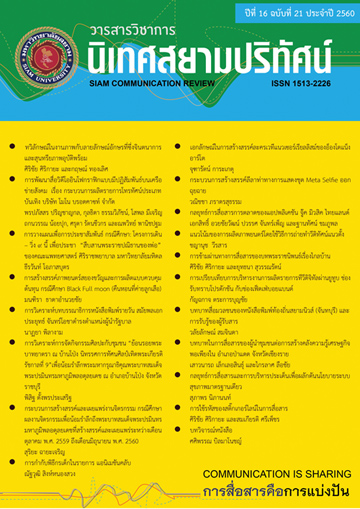การข้ามผ่านทางการสื่อสารของบทพระราชนิพนธ์เรื่องไกลบ้าน
Main Article Content
บทคัดย่อ
งานวิจัยชิ้นนี้มีวัตถุประสงค์เพื่อให้ทราบลักษณะของการข้ามผ่านการสื่อสารของบทพระราชนิพนธ์เรื่องไกล บ้านในแต่ละลำดับของการสร้างความหมายและเพื่อให้ทราบลักษณะขององค์ประกอบการสื่อสารที่เกิดขึ้นจากการข้ามผ่านทางการสื่อสารของบทพระราชนิพนธ์เรื่องไกลบ้าน ผู้วิจัยใช้วิธีวิจัยเชิงคุณภาพ (Qualitative Research) โดยการวิเคราะห์จากบทพระราชนิพนธ์เรื่องไกลบ้านทั้งในรูปแบบพระราชหัตถเลขา หนังสือเล่ม และรายการสารคดีอาหารทางโทรทัศน์ รวมทั้งการสัมภาษณ์เชิงลึกจากผู้เชี่ยวชาญ เพื่อดูลักษณะความสัมพันธ์ที่เกิดขึ้นระหว่างองค์ประกอบต่าง ๆ ของการสื่อสารที่ใช้ในการสร้างความหมายของบทพระราชนิพนธ์เรื่องไกลบ้าน ผลการศึกษาพบว่าลักษณะการข้ามผ่านการสื่อสารของบทพระราชนิพนธ์เรื่องไกลบ้านปรากฏรูปแบบความสัมพันธ์ในลักษณะที่สื่อในลำดับก่อนถูกแปลงมาเป็นสารในสื่ออีกลำดับหนึ่ง นอกจากนี้ยังพบการควบรวมสื่ออยู่ร่วมกันในลักษณะที่เป็นคู่ปฏิปักษ์สัมพันธ์ และเมื่อเกิดการ ข้ามผ่านทางการสื่อสารแล้ว องค์ประกอบการสื่อสารต่างก็เปลี่ยนสถานะและต่างมีส่วนร่วมกันในการกำหนดลักษณะของเนื้อหา อีกทั้งยังปรากฏการเปลี่ยนแปลงทั้งมิติด้านการสื่อสารและอัตตะการสื่อสารเมื่อมีการข้ามผ่านทางการสื่อสารในบริบทของเวลาและสถานที่ที่เปลี่ยนไป
Article Details
เอกสารอ้างอิง
กฤษณ์ ทองเลิศ. (2545). การผสานรูปแบบ การสื่อความหมายและจินตสาระของผู้รับสารเป้าหมายที่มีต่องานภาพถ่ายกับลายลักษณ์อักษรในงานโฆษณาทางสื่อสิ่งพิมพ์. วิทยานิพนธ์ปริญญาดุษฎีบัณฑิต, จุฬาลงกรณ์มหาวิทยาลัย.
เจริญพงศ์ ศรีสกุล. (2550). การออกแบบเนื้อหาส่วนควบและส่วนขยายในสื่อดีวีดีภาพยนตร์. วิทยานิพนธ์ปริญญามหาบัณฑิต, จุฬาลงกรณ์มหาวิทยาลัย.
จุลจอมเกล้าเจ้าอยู่หัว, พระบาทสมเด็จพระ. (2545). ไกลบ้าน เล่ม 1. กรุงเทพมหานคร: อักษรเจริญทัศน์.
จุลจอมเกล้าเจ้าอยู่หัว, พระบาทสมเด็จพระ. (2545). ไกลบ้าน เล่ม 2. กรุงเทพมหานคร: อักษรเจริญทัศน์.
จุลจอมเกล้าเจ้าอยู่หัว, พระบาทสมเด็จพระ.(2545). ไกลบ้าน เล่ม 3. กรุงเทพมหานคร: อักษรเจริญทัศน์.
จุลจอมเกล้าเจ้าอยู่หัว, พระบาทสมเด็จพระ. ผู้แปล. (2545). ตำราทำกับข้าวฝรั่ง. พิมพ์ครั้งที่ 3. กรุงเทพฯ: อมรินทร์พริ้นติ้งแอนด์พับลิชชิง.
ถิรนันท์ อนวัชศิริวงศ์. (2557). ปรัชญานิเทศศาสตร์ กระบวนทัศน์ในการพัฒนาทฤษฎีและศึกษาวิจัยการสื่อสาร. กรุงเทพมหานคร: จรัลสนิทวงศ์การพิมพ์.
ศิริชัย ศิริกายะ. (2558). ข้อเสนอแนะประเด็นการสื่อสารเพื่องานวิจัยนิเทศศาสตร์ตามแนวคิด “ปฏิปักษ์สัมพันธ์” (Symbiosis) ในยุคดิจิทัล. วารสารนิเทศสยามปริทัศน์ 14(16), 7-11.
ศิริชัย ศิริกายะ. (2558). แบบจำลองการสื่อสารในยุคดิจิทัล. วารสารนิเทศสยามปริทัศน์ 13(15), 8-13.
ศิริชัย ศิริกายะ. (2526). แบบจำลองเชิงลู่เข้าของคินเขด. วารสารนิเทศศาสตร์ 2(4), 47-74.
ภาษาอังกฤษ
Fiske, J. (1990). Introduction to Communication Studies. London and New York: Routledge.
Houston, K. (2016). The Book: A Cover-to-Cover Exploration of the Most Powerful Object of Our Time. New York: W.W. Norton & Company, Inc.
Jenkins, H. (2006). Convergence Culture: Where Old and New Media Collide. New York: New York University Press.
Littlejohn, S. W. (2007). Theories of human communication. Belmont, CA: Thomson/Wadsworth.
McLuhan, M. (1964). Understanding media: The extensions of man. New York: McGraw-Hill.
McQuail, D. (1994). McQuail’s mass communication theory. (3rd edition). London: Sage Publications.
Ong, W. J. (1982). Orality and literacy: The technologizing of the word. London: Methuen.


